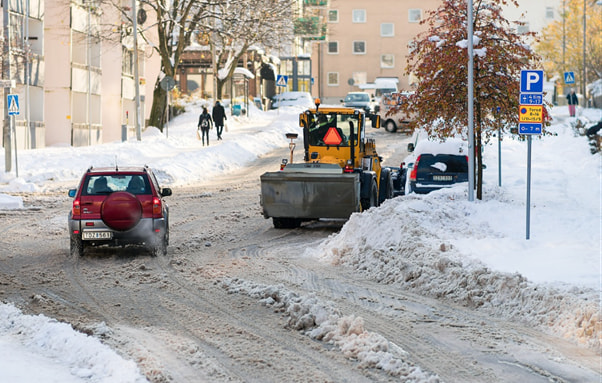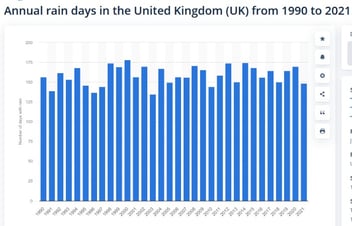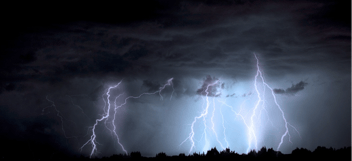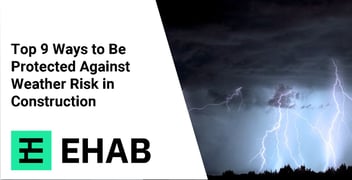When the temperature drops, construction workers need to take extra precautions to stay safe in cold weather. Construction cold weather risk assessments can help identify potential hazards and prevent accidents. They also help ensure the health and safety of construction workers.
What are Cold Weather Risks?
Cold weather risks can be grouped into two broad categories, those that cause structural damage and ruin materials and those that cause injury to workers.
Risks that Cause Structural Damage and Ruin Materials
Frozen ground can cause foundation and excavation problems
Frozen ground can become unstable and cause foundation and excavation issues. This can result in damage to structures and equipment.
Frozen pipes can lead to burst pipes and flooding
Frozen pipes can cause serious damage if they burst. This can result in property damage and costly repairs.
Ice accumulation on roofs can cause collapse
Ice build-up on roofs can result in structural damage and even collapse. It is important to monitor roof conditions during dangerous cold weather conditions and take preventative measures to remove ice accumulation.
Concrete doesn't cure well in very cold weather
Cold temperatures can affect the curing process of concrete, weakening structures and cracks. For example, at 4 degrees centigrade, concrete requires 14 hours to set, 19 hours at -1 degrees centigrade, and does not set at very cold temperatures of -7 degrees Celsius. Consult the specification of the concrete to determine the level of cold that it can withstand.
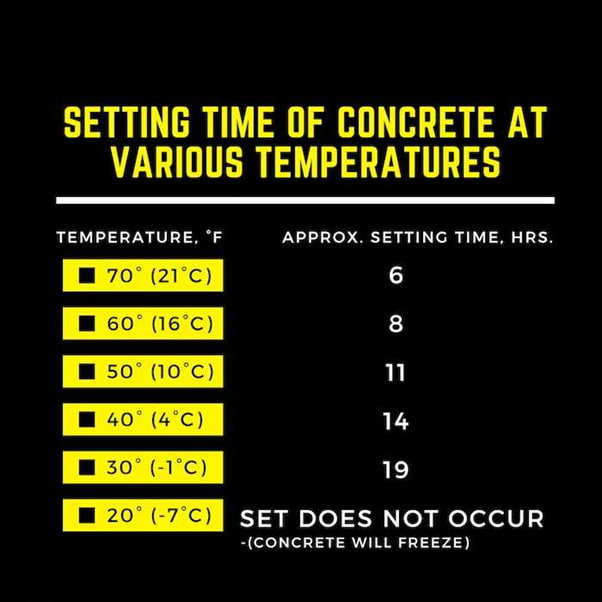
(Image source: forconstructionpros.com)
Risks that Cause Injury to Workers
Hypothermia and frostbite
Cold weather can lead to hypothermia, frostbite, and even severe shivering fatigue resulting in severe injury or even death. Workers need to stay warm and dry and take frequent breaks to warm up.
Slips and falls on icy surfaces
Icy surfaces can increase the risk of slips and falls, leading to injury. Monitoring walkways and taking measures to remove ice build-up and improve traction is crucial.
Slower reaction time in cold weather
Cold weather work can affect a person's physical abilities, leading to slower reaction times. This has been established in clinical trials. A 0.5-degree centigrade decrease in body core temperature significantly increases reaction and movement time, indicating a general deteriorating effect of lowering body core temperature on information processing. In extreme cases, cold weather can even lead to irrational or confused behaviour, further increasing the risk of accidents and injury on the site.
What Does the Law State?
There is no specific law in the UK that addresses cold weather risks in construction. However, several acts and regulations offer guidance. Section 2 of The Health and Safety at Work, etc, Act 1974 requires employers to provide their employees with a safe and healthy working environment.
Section 3 of the Management of Health and Safety at Work Regulations 1999 requires employers to assess the risk to the health and safety of their employees arising out of their work activity.
Section 34 of the Construction (Design and Management) Regulations 2015 states that the employer must arrange the construction site to provide protection from adverse weather, taking into account the purpose for which the site is used and any protective clothing that may be necessary.
What Is a Cold Weather Risk Assessment?
Assessing the risk to workers' health from working in a cold environment and potential damage to the structures and materials requires considering both personal and environmental factors.
Personal factors include:
- The activity level: Doing physically demanding work in cold weather can increase the risk of injury and hypothermia.
- The amount and clothing worn: Wearing appropriate clothing can help keep workers warm and protected.
- Duration of exposure: Prolonged exposure to cold weather can increase the risk of injury. In addition, long periods of cold weather adversely affect structural integrity and materials.
Environmental factors include:
- Temperature and wind chill: Cold temperatures and wind chill can cause workers to experience hypothermia, frostbite, and increased risk of injury.
- Precipitation and ice accumulation: Slippery conditions from ice or snow can increase the risk of falls.
- Ambient temperature: The surrounding temperature and airflow can also affect a worker’s risk of injury or hypothermia.
7 Steps to Conduct a Cold Weather Risk Assessment
1. Understand the Purpose of the Risk Assessment
The first step in conducting a cold weather risk assessment is to understand the purpose of the evaluation. A cold weather risk assessment is conducted to identify potential hazards that could occur during cold weather construction activities. The assessment should also identify any controls that can be put in place to mitigate those hazards.
2. Review Relevant Documentation
The next step is to review all relevant documentation related to the project. This documentation includes the project plans, specifications, and any other relevant documents that will provide information about the project. This information will be used to identify potential hazards that could occur during construction.
3. Identify Potential Hazards
Once all relevant documentation has been reviewed, the next step is identifying potential hazards during construction. Some common cold weather hazards include frostbite, hypothermia, slips, trips, and falls. It is essential to consider all possible hazards when conducting a risk assessment.
4. Evaluate Potential Controls
Once potential hazards have been identified, the next step is to evaluate likely controls that can be put in place to mitigate those hazards. For example, some common controls for cold weather hazards include providing warm clothing for workers, having a designated warm-up area for workers, and having a plan for dealing with emergencies such as frostbite or hypothermia.
5. Implement Controls
After potential controls have been evaluated, the next step is to implement those controls on the construction site. This may involve providing necessary equipment or training for workers and regularly monitoring the controls' effectiveness.
6. Monitor Conditions
Once controls have been implemented, regularly monitoring conditions on the construction site is important. This includes monitoring the weather forecast and adjusting work schedules as necessary. Additionally, it is vital to monitor workers for signs of cold-related injuries such as frostbite or hypothermia and provide medical attention as required.
7. Review and Update Assessment Regularly
It is essential to regularly review and update the cold weather risk assessment as conditions on the construction site change. This includes checking the weather forecast and adjusting work schedules as necessary.
EHAB Weather Risk Management Platform
An effective tool for conducting cold weather risk assessments is the EHAB Weather Risk Management Platform. This platform allows users to track and monitor weather conditions, set up alerts for potential hazards, and identify controls to mitigate those hazards. It also provides for regular reviews and updates of the risk assessment as conditions change. For information on how EHAB can help you conduct a weather risk assessment, sign up for a free 30-minute demo.
